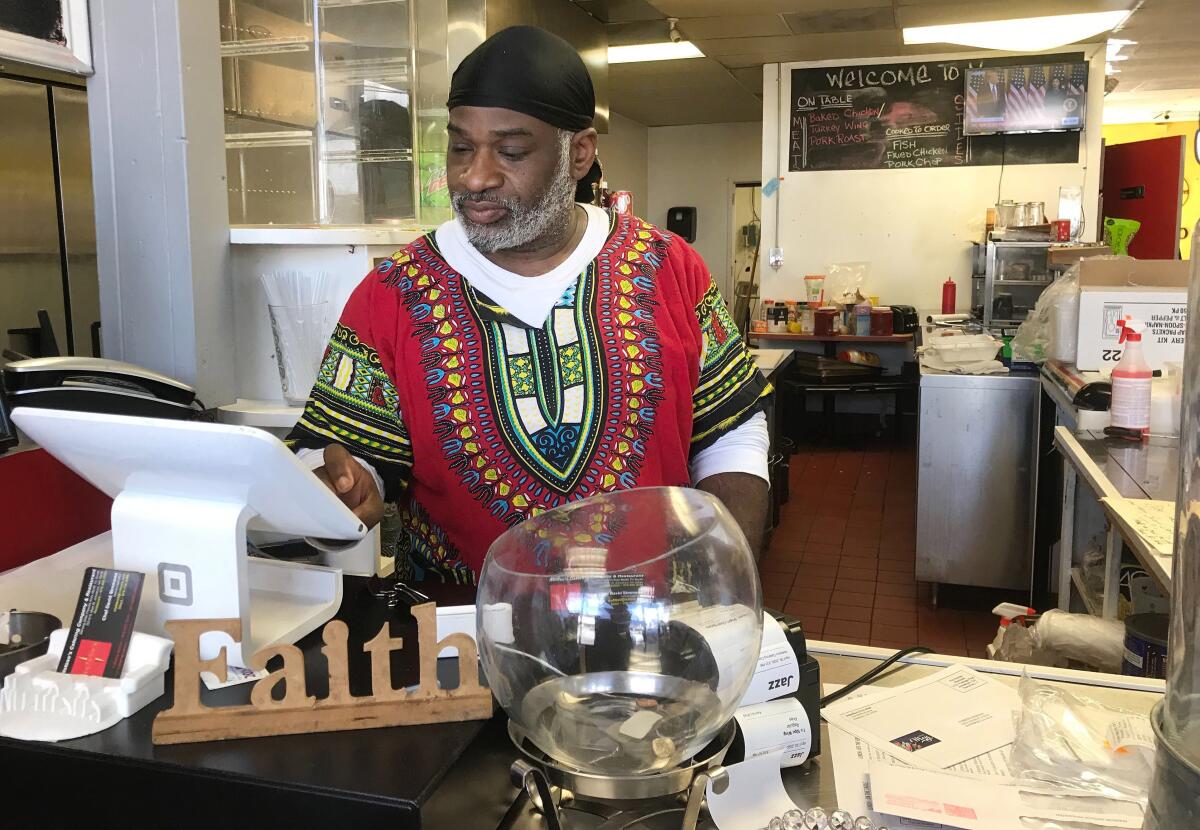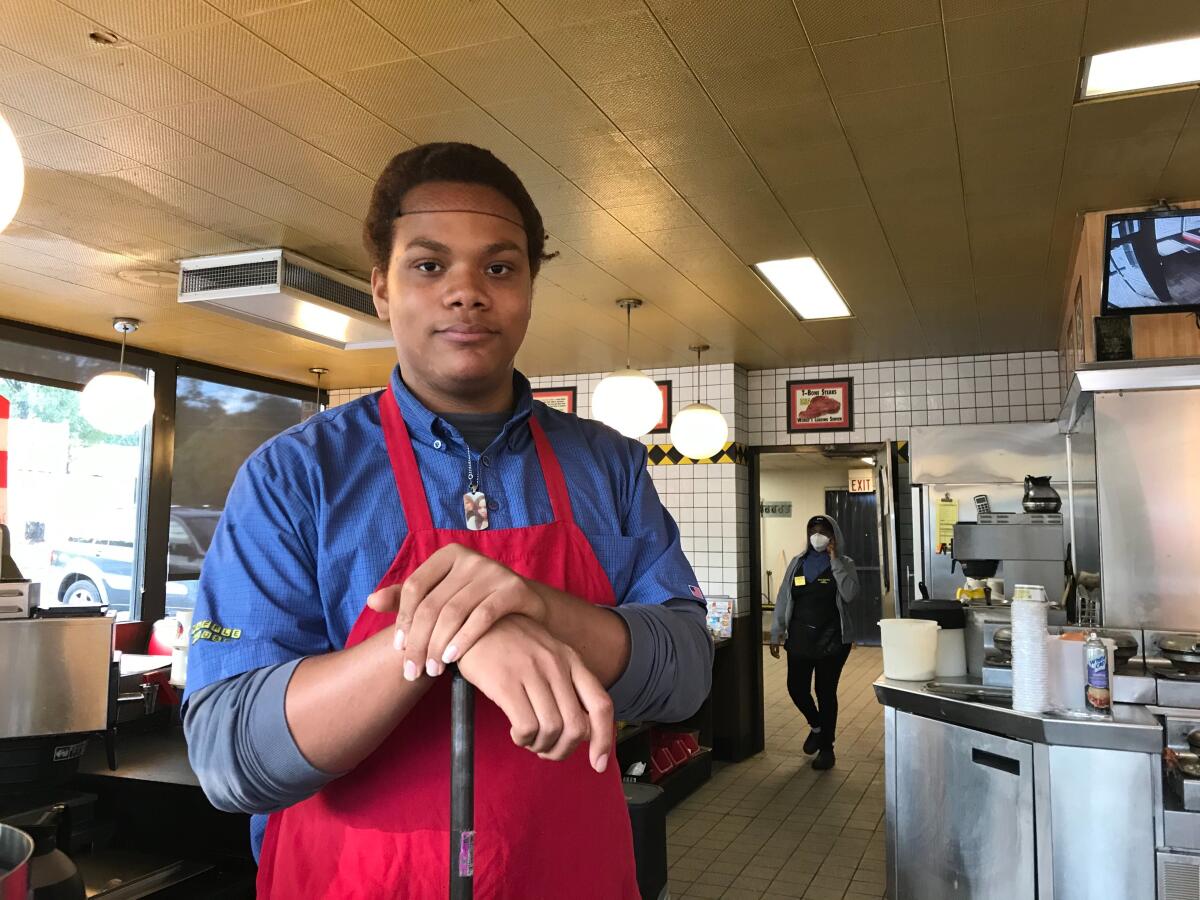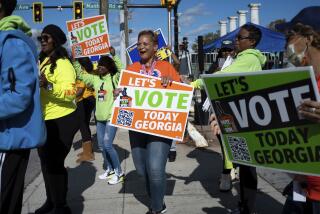‘It’s too soon’: In small towns and big cities, Georgia’s experiment in reopening moves slowly

- Share via
JONESBORO, Ga. — At the end of a nine-hour workday, David Simmons sprinkled a cloud of lemon-pepper over a pile of chicken wings, stepped up to his cash register and shook his head.
He had cooked three batches of wings for two customers, bringing in just $23.97 — a fraction of the $300 he typically made each day at his small soul food joint.
“I don’t think it’s worth staying open,” the 48-year-old business owner said as he scanned his empty NoToSo’s restaurant in a strip mall in Jonesboro, a sprawling suburban town about 15 miles south of Atlanta. “I’m just hanging in here until I can’t.”
A week after Georgia Gov. Brian Kemp plunged the state into the middle of a national social experiment — rolling back restrictions on businesses in an effort to restart the economy after a monthlong shutdown to halt the spread of COVID-19 — many business owners and workers remain a long way from getting back to normal.
In small towns and big cities, many have ignored Kemp’s order lifting restrictions on gyms, barbershops, hair and nail salons, tattoo parlors and bowling alleys last Friday and allowing restaurants and movie theaters to open on Monday.
Most restaurants that have opened are proceeding cautiously, offering to-go service but keeping their dining rooms closed.
“I’m just not comfortable with customers dining in right now,” Simmons said. “It’s too soon. I would love for businesses to be open and booming, but it could put more people at risk.”
Across Georgia, mayors from towns as far apart geographically and socioeconomically as Atlanta, Albany and Tybee Island have joined public health experts in criticizing Kemp, arguing that reopening too early could lead to a spike in new infections. Even fellow Republicans — President Trump and Rep. Doug Collins — have piled on, condemning Kemp for moving too quickly and not consulting local leaders.
More than 27,000 Georgians have tested positive for the virus. Since noon on Monday, the number of deaths across the state has jumped from 942 to 1,162 as of Friday afternoon. While the state has ramped up testing in the last week, it continues to lag behind other states.
Still, Kemp has pressed on, allowing the state’s shelter-in-place order to expire at midnight Thursday, while urging Georgians to practice social distancing and wear face coverings in grocery stores and when picking up food at restaurants.
As a string of other Republican-led states follow — Texas on Friday allowed restaurants, retail stores, movie theaters and malls to serve customers — many small-business owners and workers are still struggling to decide: Should they adopt a cautious approach to the health risks and remain closed? Or slowly get back to normal in an effort to salvage their livelihoods or pay the rent?
In Jonesboro — a once mostly white rural town where Margaret Mitchell set “Gone With The Wind,” and that has in recent decades morphed into a predominantly black suburb of Atlanta — some restaurants were closed entirely. But the vast majority, from big chains such as McDonald’s to the local Fireside Jamaican Restaurant, were taking only to-go orders.
On Tara Boulevard, a bustling highway lined with condominium complexes, strip malls, tire shops and auto dealers, Country Charm Buffet was shuttered, no longer serving oxtails, catfish, turkey wings and chitlins.
A Burger King restaurant nearby was open for dine-in customers. But every other table was marked off with blue masking tape and chairs were draped in clear plastic. No one was eating inside.
“It’s all drive-through customers,” said Christiana Threats, an assistant manager, as a line of sedans and SUVs snaked around the building.
Taking an order for a tlayuda at the Taquería La Oaxaqueña, Jessica Sanchez, a 26-year-old server, said that her boss held a meeting with staff to discuss what they felt comfortable with. Everyone agreed they were not ready to let customers back into their dining area.
The decision was costing her money — she was making just $200 in tips a week compared to her usual $600 — but she felt it was safer in the long run to avoid a rash of new infections.
But even restaurants that opened for dine-in service did not see a lot of customers.
At Breakers Korean BBQ in Duluth, a suburb about 20 miles northeast of Atlanta, Cristy Youn, a 19-year old server, said few people were choosing to dine inside the restaurant.
Youn, a psychology student at Georgia State University, was working fewer hours and struggling to make tips. Usually she made $100 to $130 in tips each day. On her last shift, she made just $25.
“It’s pretty slow,” she said Thursday afternoon. “I thought people would be tired of staying home, but no one has come in all day.”
In his rush to reopen, Kemp appears to be moving ahead of public sentiment in Georgia. About 62% of voters here disapprove of his decision to ease restrictions, according to an online survey conducted last week by the University of Georgia. While there is a partisan divide in attitudes to reopening, about 52% of Republicans oppose doing so, compared with 73% of Democrats and 59% of independents.
“If the virus subsides and Georgia is one of first states to get the economy restarted, we would be ahead of the curve,” said M.V. “Trey” Hood III, a professor of political science at the University of Georgia. “But it is a risk because people are really still anxious about this.”
Restaurants that reopen to dine-in customers have to follow a long list of safety requirements. They cannot allow more than 10 patrons per 500 square feet inside the restaurant at a time, and must rearrange dining rooms to allow six feet between parties. They also must require all employees to wear face coverings and discontinue salad bars and buffet service.
Inside a Waffle House diner on Tara Boulevard, Kyla Spradling, 16, said she quit two weeks ago, and decided to come back to work only when her boss agreed customers could not eat inside.
“As a server, I was at risk, and I didn’t think they were handling it correctly,” she said from behind the cash register.

Still, she said, she needed to earn money. She and her co-worker Carlos Mckibben, 19, had propped black plastic crates on the floor against the counter to stop customers from getting too close.
As a cook, Mckibben made $10.60 an hour. Living in the American Inn & Suites behind the diner, he was struggling to pay $420 a week in rent.
“I’m barely making it,” he said.
More than 266,000 Georgians filed initial unemployment claims last week, up about 19,000 from the previous week, according to the Georgia Department of Labor. That brings the total number of claims in the last six weeks to nearly 1.4 million — more than the last four years combined.
Many Georgians suspect Kemp is moving to get workers off the unemployment rolls and shift the burden onto small-business owners and workers.
The state Department of Labor has said that people who felt unsafe returning to the workplace would not necessarily continue to receive unemployment benefits — unless they were immune-compromised, diagnosed with or living with a family member diagnosed with COVID-19, or caring for someone in a high-risk category.
A stylist at a hair salon in Douglasville, Ga., who declined to give her name for privacy reasons, said she thought state leaders were more concerned about the money they were paying out than the health of Georgia residents.
“This is going to be the trial run and we’re pretty much like the test dummies,” she said. “Basically, it gives me no faith in the governing system at all. I think once they ran out of money — you know, they got the record highs in the unemployment applications — it’s kind of like ‘OK, send them back in. We can’t afford to take care of these people.’”
In the small town of Cuthbert, about 150 miles southwest of Atlanta, Mayor Steve Whatley said most restaurants and other businesses were not picking up normal routines. The Dawg House on the historic town square reopened Monday to sell hot dogs and hamburgers, but only for curbside pickup. The Townhouse restaurant was offering its home-cooked meals to go.
“People are a little bit apprehensive,” Whatley said. “Things are beginning to open slowly, but I think there is concern about another surge happening.”
The rural community of about 3,400 residents has been hit hard by the virus, with 159 confirmed cases and 19 deaths after an outbreak at local nursing home.
Still, Whatley said he was cautiously optimistic that the town would slowly reopen.
“If we don’t begin to open back up, the impact on the economy is going to be devastating,” he said.
In Jonesboro, David Simmons said he did not think NoToSo’s would survive without more customers. But even if he allowed people to dine in, he could likely only seat about eight to 10 people at a time if he followed the state’s social distancing guidelines.
On Thursday, he called the landlord of his strip mall to tell him he couldn’t pay his $935 rent on Friday. He hoped the leasing agent of his apartment complex would work with him: He only had about half of the $980 rent due for his two-bedroom apartment.
“I trust God I will be able to make it through,” he said.
More to Read
Sign up for Essential California
The most important California stories and recommendations in your inbox every morning.
You may occasionally receive promotional content from the Los Angeles Times.











